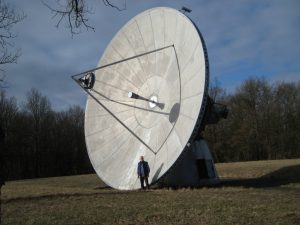Moon bounce with the 10 Meter Telescope
“Radio Astronomy is a subfield of astronomy that studies celestial objects at radio frequencies. Earth-Moon-Earth Communication (EME), also known as Moon bounce, is a radio communication technique that relies on the propagation of radio waves from an Earth-based transmitter directed via reflection from the surface of the Moon back to an Earth-based receiver.” Wikipedia.
The astronomical relation to a passive radio Moon reflection transmission is clear. Because of the elevated position of the observatory, the radio telescope Stockert with its telescope offers a perfect place for experiments on ambitious Moon transmissions. In addition to operational radio skills astronomical knowledge plays a key role in this. The opportunities made possible by our amateur radio operations therefore connect intimately with radio astronomical themes. A welcomed connection – and – a bonus point for education at Stockert!
EME Transmissions with the 10 meter telescope at the observatory are conducted using 10 GHz radio signals and are transmitted to the moon in classical morse code A1A, using Single-sideband modulation SSB or computer software WSJT. The weak echoes that are emitted via the reflection of these signals on the moon’s surface are then recorded on earth. A particular advantage of this specific operation style is that, even using higher frequencies, worldwide radio communication is still possible – as long as the moon is situated above earth’s horizon for both stations at the time of communication.
The greatest difficulty with EME presents itself within those weak signals that, after their reflection on the moon’s surface (which is bend “the wrong way” for reflectors and which rocky surface reflects poorly in itself) and long travels of 750000km (466028 miles) (which results in a significant delay of the echo), still manage to reach earth’s surface. In these cases, usually, only a ten millionth of the originally emitted energy reaches back to us. Modern techniques (SDR) support more demanding radio operations with their sensitive, optical waterfall-diagrams.
Stockert’s 10 meter telescope is especially practical for these 10 GHz-EME-operations. These reflected signals are, with the maximum allotted transmission power of 75 watts and an antenna gain of roughly 57 dBD, truly magnificent to record. The aperture angle is with its 0.19° significantly smaller than the observable part of the moon’s surface which is at 0.55°. It is therefore unsurprising that Astropeiler Stockert with is tightly focused “ideal antenna” is proud to be in the midst of the world’s most powerful 10-GHz amateur radio stations.

